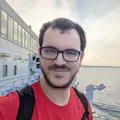It’s 9:44 on a sunny Sunday morning in May in Lyon, France. I’m basking in the sun after having an excellent croissant for breakfast when I suddenly receive a text on my phone that makes me curse audibly in public: the train I was waiting to catch in less than half an hour has been delayed by 20 minutes. Without figuring out all the details, I immediately know that that is going to destroy all the work that I’ve been doing for the past 24 hours.
How did I end up in this position? Well, after participating in last year’s Lupine Race to Albania and having so much fun, I signed up as soon as possible for the following edition, which was called “The Marrakesh Express”. This edition will cover the 2,300 km between London and Marrakesh from May 17th to 24th, 2025.
I was really excited about this edition of the race, as it would pass through my native region of Andalusia in southern Spain, and Marrakesh is one of my all-time favourite destinations, having visited multiple times.
In case you don’t know, the Lupine Race is a public transport race, organised by the folks at Lupine Travel. Trains, buses, and ferries are allowed. Taxis are only permissible within city limits, and you can’t catch a plane, helicopter or hot-air balloon. Whilst you know the start and end locations, there are a series of checkpoints that you need to clear along the way. The location of these is only revealed at the start of the race, so you can’t plan in advance. The exception is the first stop in continental Europe, which is always announced beforehand, as getting a last-minute train over the English Channel would be prohibitively expensive or outright impossible otherwise. For this race, we know that the first checkpoint will be situated in Paris.
This adventure begins with me heading to the Herne Hill Velodrome in South London, accompanied once again by my ever-supportive wife, Cris. We arrive at Brixton station, on the Victoria Line, which is not the closest station to the Velodrome, but is the nearest one within the area of coverage of the TfL cycle hire scheme, also known as Boris Bikes.
You see, in previous editions, the race started from Trafalgar Square, which made it trivial to get to St Pancras station, where the Eurostar departs: a quick hop on the Piccadilly line of the Tube and you arrive there in under 20 minutes without breaking a sweat. This time, however, the start has moved to the aforementioned Herne Hill Velodrome, an iconic venue that hosted the cycling events of the 1948 London Olympics.
The first challenge we racers are facing is getting from there across London to St. Pancras to catch the Eurostar. The race starts at 10:30 sharp, and the first train to Paris departs at 11:31. A lot of participants will probably have decided to take the following train at 12:31, but when competing for the fastest arrival, a difference of one hour could be irrelevant, or could cascade and compound into an ever bigger delay.
Getting on that first train is going to be tough, and the most straightforward option is getting a Thameslink train direct to St Pancras at 10:42 from the nearby Herne Hill Station. There are two problems with that option, though: first, the station is 1.3 km away from the start line, so getting there quickly enough to catch that train would mean having to run a little bit, and I know from the last race that the opportunities to get a shower during the event are pretty slim, so sweating that early into it is not appealing at all. Second, British trains can be unreliable at the best of times, and I definitely don’t want to get stuck there and miss the Eurostar.
With all of that in mind, I came up with a different plan: to rent an electric bike from the closest docking station, carry it with me to the Velodrome, and use it to get back to Brixton. On the one hand, that means not having internet access for the half an hour or so that it will take me to get there. On the other hand, Victoria line trains are fast and frequent, and I could even get to the Eurostar boarding area a couple of minutes earlier than if I were to take the Thameslink train.
We arrive, bike in hand, at the Velodrome a little bit after the advertised opening time of 9:00 AM. I go to check in and collect my race pack (which we are strictly prohibited from opening before the race starts), GPS tracker, and swag, and say hello to the organising team and other racers I met during last year’s edition. It’s soon time to line up at the starting line and listen to the checkpoint reveal.
The Checkpoints
Over the speaker, Race Director James Finnerty introduces the event and announces the checkpoints we will need to hit. The first one we already knew:
- Paris, where racers will have to clear two checkpoints, depending on which route they choose.
Then comes a surprise: in previous editions of the race, checkpoints were independent of each other, and competitors were able to choose freely whenever there was more than one option. For the first half of this race, however, we’re forced to choose among three fixed routes:
-
The Pilgrim’s Picnic, which emulates the Camino de Santiago and passes through:
- Saint-Jean-Pied-de-Port, just north of the Pyrenees in the French Basque Country.
- Santiago de Compostela, the destination of the Camino
-
The Mountain Goat, an alpine itinerary with stops in:
- Chamonix, the base for the ascent of Mont Blanc
- Andorra La Vella, the capital of the microstate in the middle of the Pyrenees
-
The Island Hopper, a ferry-heavy option including:
- Toulon, in the Côte d’Azur
- Palma de Mallorca, the capital of the Balearic Islands.
From there, all routes converge into a single itinerary:
- Valencia, on the eastern coast of Spain
- Tangiers, the Moroccan port where we’ll enter Africa
- Marrakesh, where racers must clear a final checkpoint before heading to the finish line

I don’t register all the options, but I decide against opening the race pack right now, as it’ll be a hassle to get it out and back again into my backpack in the minute or so before the race starts. I’ll have time to check it on my way to the Eurostar.
Leg 1: London to Paris
The race starts as soon as the clock hits 10:30. I navigate through the crowd with my bike and get on it as quickly as possible, easily overtaking everyone else. I’m in the lead!! The bike ride goes smoothly, and I manage to get to a Victoria line train in Brixton in just over 11 minutes.
The downside of this strategy is that the Victoria line doesn’t have mobile coverage yet, so for the 20 minutes I’m riding the Tube, I won’t be able to check itinerary options. Instead, I can open the race pack and start locating where the checkpoints are on the map the old-fashioned way.
Using the European Rail Atlas, I locate the most obscure ones, Chamonix and Saint-Jean-Pied-de-Port, and find that both are part of the French railway network, with Geneva and Bayonne being relatively close major cities. At this point, of course, I don’t need to worry too much about the second half of the race, as all routes converge in Valencia.
I look at the options with the routes traced on the map, and I think I’m going to take The Pilgrim’s Picnic. Getting in and out of Saint-Jean-Pied-de-Port should be easy enough, given its proximity to Bayonne. The radial design of the Spanish railway network is particularly challenging, making the fastest route to Santiago likely to involve travelling south, possibly all the way to Madrid, then returning north to backtrack and head to Valencia. However, there should be plenty of connections available, and many of them likely involve high-speed trains.
The problem with the Mountain Goat route, which is the most direct one, is that it goes through Andorra. Getting to Chamonix, a major mountain resort town, and one that is relatively close to Turin and Geneva, shouldn’t be too hard. But I already know that the only way to get to Andorra is by bus, either from Toulouse or Barcelona, or from a nearby train station that is infrequently served by night trains from Paris.
I don’t really think much of the Island Hopper route. The Interrail map indicates that the ferry from Barcelona to Palma takes approximately six and a half hours, and that the ferry from Palma to Valencia takes around nine hours. Surely the other two routes offer faster options to get to Valencia.
While I’m still considering this, the train arrives at King’s Cross St Pancras, and it’s time to overtake the tourists heading for Platform 9¾. I arrive at the Eurostar check-in 27 minutes after departing from Herne Hill, which is a personal record. I breeze through security and passport control, and realise that my train isn’t even boarding yet.
Since I had booked a first-class seat at great expense, which allows me to check in just 15 minutes before the train departs, instead of the usual 30, I decide to make the most of it and access the first-class lounge, where I’ll also have better Wi-Fi.
I grab a Coke Zero and start checking the itineraries. The journey through Santiago is actually very slow, as it seems I won’t be able to make it to Valencia until at least Monday at 11:30 AM. The reason for this is that there don’t seem to be any overnight connections out of Saint-Jean-Pied-de-Port, which means I would be able to get there tonight but would have to wait until past 9:30 AM on Sunday to return to Bayonne.
I start looking at the Mountain Goat route next. There is a TGV from Paris Gare de Lyon to Geneva at 16:10 that seems quite attractive, as I’ll arrive in Paris at 14:53, so I should be able to board it after clearing the two checkpoints in the French capital. It also means that anyone who is taking the next Eurostar to avoid the rush to St Pancras won’t be able to get it. Furthermore, the TGV arrives in Geneva at 19:29, and I can take a bus to Chamonix from there at 20:05, arriving at 22:00, which is relatively fast considering the remote location of Chamonix.
The problem, I know, is going to be getting from the Alps to the Pyrenees and into Andorra, but before I can check how much of an issue that will be, I hear the boarding call for my train. Not wanting to miss it, I finish my drink quickly and go join the boarding queue. On the way out of the lounge, I spot fellow racer Sam S. I’m tempted to say hi, but she looks really focused on her screen, so I decide against it. I’m not totally happy to see her either: I knew some more people were going to be able to catch the first Eurostar, but a boy can hope…
Anyway, I make my way to the far end of St Pancras –I’ve booked the first seat of the train, looking to get into Paris without anyone or anyone’s luggage holding me back, and board.
At least this year, I get mobile reception on the train, which wasn’t the case last year. Although coverage is patchy at best while still in England, it improves once we’re in the Channel and works perfectly fine once we’re in France. In any case, I return to reviewing my itinerary options. I was right in thinking that getting through Andorra was going to be a pain. At first glance, the fastest option appears to be going to Barcelona first and then heading back up the Pyrenees, which doesn’t seem ideal. However, this itinerary puts me in Valencia at 4:42 AM on Monday morning, which is not bad at all.
I then look at the Island Hopper route quite sceptically. I prefer not to depend on ferries, as their schedules can be unpredictable, to say the least. A quick glance puts the arrival time into Palma de Mallorca at 6:00 on Monday morning, and I stop looking there. Now, if instead of letting me get carried away by a severe case of confirmation bias, I’d have spent a few minutes looking deeply into the route, I could have noticed that there was a much faster route: going quickly from Touloun to Barcelona, taking the ferry from Barcelona to the northern port of Mallorca, Alcudia, and then crossing the island before hopping in an overnight ferry from Palma to Valencia. That itinerary would put you in Valencia at 8:00 AM on Monday, and relying on much less tight connections than the Mountain Goat option, which, from my calculations, hinged on a 5-minute connection in Narbonne.
I would not realise that the fastest route through Palma existed until it was too late, with terrible consequences, as you might be anticipating. Looking back, however, I think I would still have taken the high-risk, high-reward option of going through Chamonix and Andorra.
Time flies, though, and I need to commit to my plan: clear the Paris checkpoints and take the train to Geneva. Since this race was going to cross Spain, where the Interrail pass is basically useless, and Morocco, which is not covered at all by it, I have decided not to purchase one; therefore, I’ll need to pay full price for the tickets. The last-minute ticket price for the international TGV to Geneva is so high, over €180, that it’s actually cheaper to buy the SNCF Advantage discount card, which costs €50. Since it’s only €5 more to upgrade to first class, I think I might as well do that.
Now I need to sort out my tickets for the Paris metro. I’ve heard that RATP, the Île-de-France public transport agency, are finally getting rid of paper tickets. Only now, as the train inches closer and closer to Paris, do I realize that I have failed to plan for this properly: getting the info on how to pay for the Paris metro is something that I should have cleared well before the start of the race, as I’m now having to waste precious time figuring it out.
It turns out that instead of doing the sensible thing and allowing contactless cards to be used for payment at the turnstiles, you have to buy tickets on your phone via the Bonjour RATP app. I install the app, sign up, and attempt to purchase tickets, only to discover that to do that, you need to install a second app that just runs the background process to hold and activate the tickets. After spending too much time setting up the bloody thing, running device compatibility checks, and reciting the Marseillaise in reverse three times, I finally manage to purchase three single tickets and get on with my day. By now, though, Paris is getting really close.
Leg 2: Paris to Chamonix
The Eurostar actually pulls into Gare du Nord 5 minutes early, at 14:48. As planned, I’m the first of the passengers to step into the station. I’m familiar enough with its layout to go straight to the Metro station, and I’m already waiting for a Line 4 train at 14:51.
The rush is justified. Before leaving the French capital, we need to clear two checkpoints:
-
The first one is common to all racers, and we can choose between Ladurée in Rue Royale near the Madeleine church, or VG Pâtisserie, a vegan shop on Boulevard Voltaire.
-
The second one depends on which of the three itineraries you’ve chosen. For the Mountain Goat route through Chamonix and Andorra, we’re required to go up Montmartre to get acquainted with heights, and take a photo of Le Passe-Muraille, a sculpture of a man passing through a wall.
Now, nowhere on the race pack says that we need to hit them in that order, just that we need to clear both checkpoints before getting out of Paris. If I had realised that, I could have gone to Montmartre first, then to Ladurée, and then to Gare de Lyon, doing a counter-clockwise tour through the Rive droite.
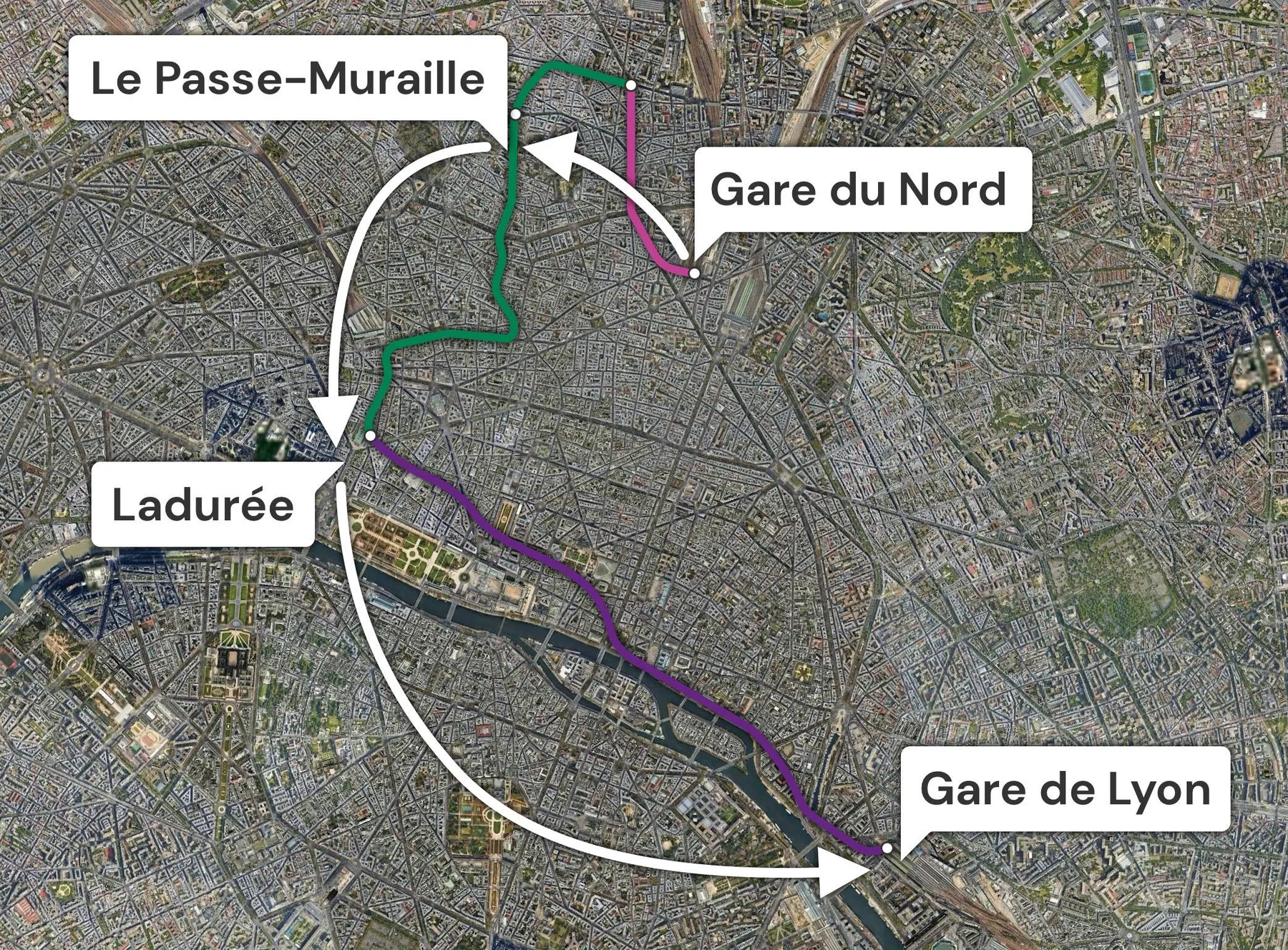
Instead, I assumed that I had to go to Ladurée first. That means I have to head south from the Gare du Nord to the pâtisserie, then go back up north to Montmartre, before tracing a long diagonal to the southeast to get to Gare de Lyon. I should still be able to make it, but I’ll need to run.
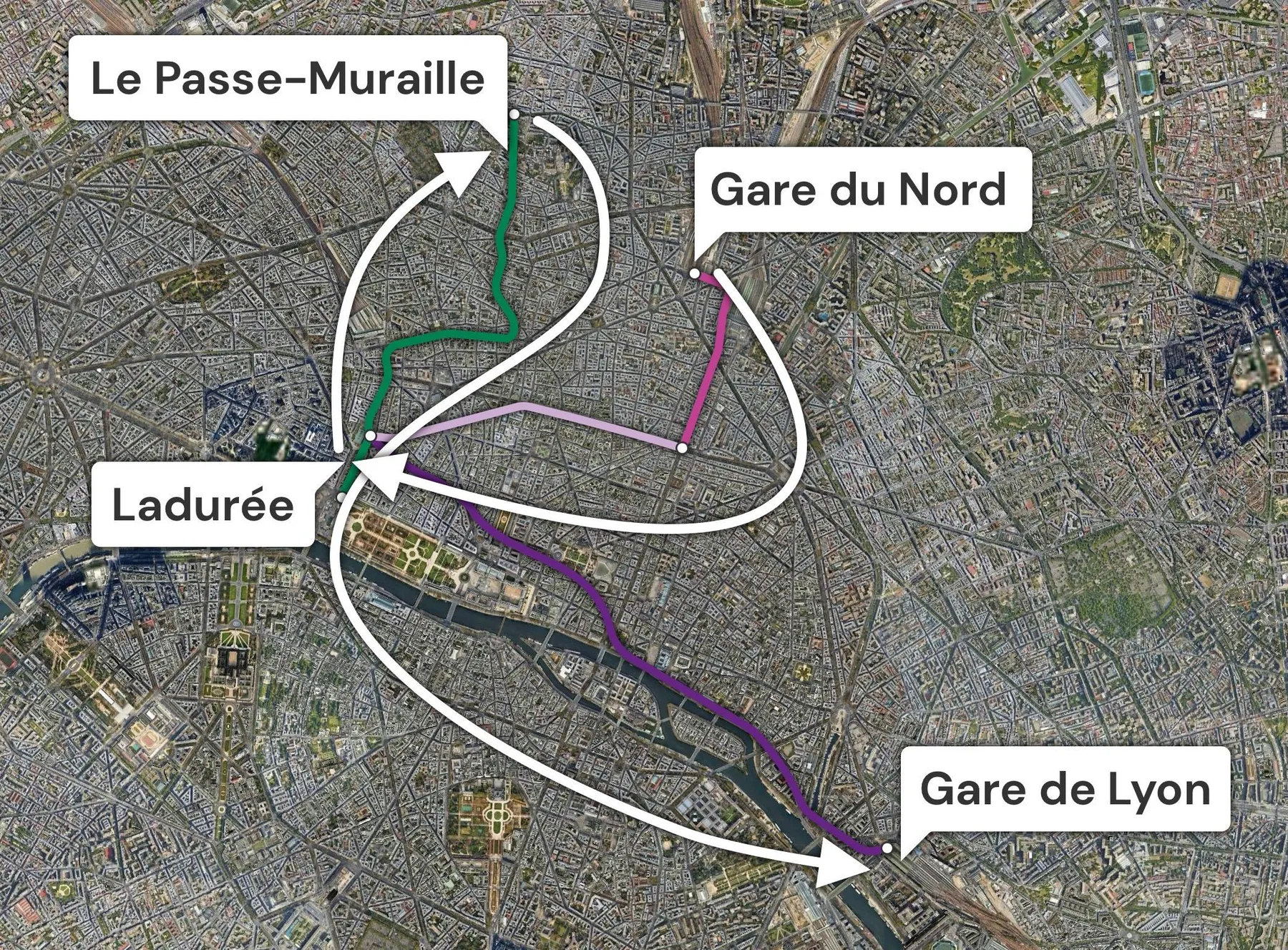
After riding the Line 4 for four stops, I change at Strasbourg Saint-Denis, and while waiting for the Line 8 train to arrive, I spot Sam S. again and we wave at each other. After waiting for the train for five excruciating minutes, I don’t spot any other racers there. Since I think that we need to hit the checkpoints in order, and Ladurée made way more sense than VG Pâtisserie for any of the three routes (that’s the first thing I checked back in St Pancras), I wonder for a moment if this race’s competition isn’t going to be so fierce as the previous one, before realising that there’s no way that is going to be the case.
At 15:11, with just 59 minutes to the departure of my next train, I clear the Ladurée checkpoint. I consider buying macarons for a millisecond before realising how stupid an idea that would be. Sam S. was there with me, but when I look back at her after a couple of seconds, she is metres ahead on the way to the Concorde metro station. That’s a wake-up call, and I decide to give her a run for her money and sprint ahead like a madman. We both laugh audibly. That’s what’s great about the Lupine Race: the competition is absolutely real and fierce, but everyone takes it in good spirits.
I arrive at Place Concorde, trying to find the entrance to the metro station. I wait to cross the street, and in that time, Sam S. catches up with me. I was engrossed looking at the map, trying to see the entrance, and she takes the lead, crossing the road. I start running again, but look back on the left and spot a stone balustrade –that must be an entrance, and, in fact, it is. I devilishly laugh at leaving Sam. S fending by herself, not knowing that she’s going to take an entirely different route, and I won’t see her again until a few days later.
I take the Line 12 train direct to Lamarck Caulaincourt, the closest station to the Passe-Muraille sculpture. On the way there, I purchase my bus ticket from Geneva to Chamonix. Located under the hill of Montmartre, the station is 25 m deep. It features no escalators, only a lift and a spiral staircase. I’m pretty lucky, though, as I manage to catch a lift about to depart while I was already looking for the stairs.
Once on the ground, I make a mistake and go down the steep staircase in front of the station. Fortunately, it only takes a few meters to realise my mistake and turn back. Already strapped for time, I run uphill, dodging tourists and dash through Montmartre, approaching the checkpoint. At the crossroads next to the sculpture, I have a couple of seconds of doubt. There’s another team of racers there, and when they see me looking around and back at my phone, slightly confused, one of them signs to me to go back on my tracks.
The fact that I’m trying to puzzle out how another team could beat me to Montmartre by so much probably doesn’t help with my confused expression, as, once again, I didn’t realise you could go there first before visiting one of the pâtisseries.
I don’t think the way they’re pointing is correct, but I don’t think twice about it and follow their indication. A few metres later, I realised that there is no way the checkpoint is in that direction, and I turn back again and head to the crossroads, having figured out that the monument is just to the left of it.
I see the people in the other team laughing and pointing in the right direction now. I’m flabbergasted at what just happened. That goes directly against the rules of the race. However, I choose not to say anything because I think it wasn’t done in bad faith, and it didn’t cause me too much trouble, although it could: I need to cross to the other side of Paris to catch a train that leaves in 36 minutes and has cost me a small fortune; missing one metro train could result in missing it. I think they’re probably first-timers who don’t fully comprehend the potentially devastating implications of those shenanigans and have other things to worry about at the moment.
Being completely honest, thinking back about it as I write these lines, I’m getting belated anger, as now I can fully realise the potential ramifications of those shenanigans. If something like that happens in the future, I won’t let it slide.
Anyway, I quickly go in front of the Passe-Muraille sculpture and take the customary selfie at 15:34, before sprinting back to the same Metro station I came from. Luck seems to be on my side, and a train arrives almost as soon as I get onto the platform, after breezing down the spiral staircase. The Line 12 train takes forever to go back to Madeleine, where I change to the modern Line 14, taking me all the way to Gare de Lyon, where I finally arrive at 15:57.
I make it all the way to my train with 8 minutes to spare. It’s curious how your mindset changes when doing this race. I’m usually the kind of person who wastes too much time at airports, because I can’t bring myself to arrive less than 2 hours before a flight. Now I’m getting to a train station less than 10 minutes before departure, and it feels like plenty.
Anyway, I find my way to my seat, which I’m glad to have booked on the upper deck. Not that there were many seats available, though: I had to get a seat at a table of four, which is hell when you’re travelling solo, as you’re forced to face a stranger and make sure to not invade their personal space accidentally.
I try to connect to the train Wi-Fi, which of course doesn’t work, but thankfully, I manage to get consistently good reception for almost the whole trip. Time to polish my plan.
At this point, I’m fully committed to this route; there’s no way to turn back and choose any of the other options. I’m still fairly confident I’ve made the right choice, though.
The first thing I need to do is figure out what the Chamonix checkpoint is. Last year, the checkpoint locations were specified in the Race Pack down to the exact coordinates (well, what3words location). This time around, they’re hidden behind easy-to-solve riddles. We’re told to take a picture of the two separate statues that honour the first climbers of Mont Blanc.
Upon some lightweight research on Wikipedia, I learn that these are Jacques Balmat and Michel-Gabriel Paccard. Balmat’s statue is very easy to locate, but Paccard’s, which turns out to be just 50 metres away, doesn’t have a photo of its own on the Google Maps entry. A quick inspection with Street View and a couple of external sources confirms the location, though.
Once the spots are marked on the map, it’s time to start refining my route. So far, my itinerary puts me in Andorra at 20:00 tomorrow, which is good enough to get me to Valencia at 4:30 AM on Monday morning. That’s quite important, as I’m aiming to take the first connection out of Valencia, at 6:57 AM. As long as I can make that, I’m looking at a speedy arrival to Marrakesh on late Monday evening or just past midnight.
The problem is that on Sunday, I’ll have to make a few tight connections to get to Barcelona, from where I’ll backtrack to Andorra, before heading back to Barcelona and then overnight to Valencia. That’s quite a circuitous route.
I look at the buses in and out of Andorra. From Toulouse, there are only two buses I could take: one at 13:45, that would put me in Andorra at 18:20 and be a massive win, and another one at 17:45. The latest is more of a backup plan than anything: it’s scheduled to arrive to Andorra La Vella at 22:20, which would derail all of my onward itinerary.
Many services depart from Barcelona, which is why my original itinerary includes it. But as I mentioned above, that hinges on quite a few tight connections. It would look like this:
-
Getting to Lyon before 10:00 AM. That part is easy, since I have a couple of options that would give me plenty of time to spare.
-
Taking the 10:10 AM TGV to Toulouse and getting off in Narbonne, where I’d have a 5-minute connection to a regional train to Perpignan. This doesn’t make me too nervous, as the TGV is supposed to be the most dependable service to cross France, and the SNCF actually sells the connection as a single ticket.
-
Arriving in Perpignan at 13:48, and from there taking either the 14:00 BlaBlaCar Bus or the 14:05 Flixbus coaches to Barcelona, arriving at the North Bus station of the Catalan capital at around 16:30. The former departs from Marseille at 9:00, stopping in Nîmes, Montpellier, Perpignan, and Girona. The latter departs from Lyon at 7:30, making the same intermediate stops except for Girona, meaning that it runs direct from Perpignan to Barcelona. While this would be my preferred option, I know that bus timetables are unreliable to say the least, especially in a case like this when they have been running for hours before the stop where I would board. As long as either one is remotely within schedule, though, I should be fine.
-
Crossing Barcelona in less than 45 minutes to take the bus to Andorra at 17:15 from the Zona Universitària metro stop. This is a relatively short time window, which is why relying on buses to get to Barcelona makes me a bit uneasy.
Getting that bus to Andorra is essential, as it would leave me there at 20:00. However, in practice, it would probably arrive earlier. From what I can see, the timetables have a lot of built-in room for slack. Once in Andorra La Vella, clearing the checkpoint should be a breeze, as the required proof is getting a picture of the Andorran coat of arms, which should be pretty straightforward, especially knowing that it is featured in the national flag.
The critical bit is that I need to catch the 20:15 bus from Andorra to Barcelona. That would put me back there at 23:15, which leaves me enough time to take the 23:59 or 01:00 overnight buses to Valencia. After that, the next departure from Andorra to Barcelona isn’t until 22:15, arriving too late to catch any of those overnight buses, and making me wait until the 7:10 train, which would be catastrophic.
After careful research, I fully understand all the nitty-gritty of the itinerary, but I’m hopeful. It doesn’t seem too far of a stretch to think that I should be able to get to Toulouse in time for that 13:45 bus to Andorra, considering that I’ll arrive in Chamonaix at 22:00. I start to try to find a way to do that, when I look out of the window and realise that we must be getting close to Switzerland, as the scenery has changed quite a bit, from the cultivated flats and rolling hills of the typical French countryside, to a more alpine landscape. The sights are beautiful, and I try to take a mental break from all the planning and concentrate on the landscape for a bit, but fail. Soon enough, the train starts crossing a succession of tunnels, which leaves my phone without reception and forces said mental break on me.
Before I have time to process everything, the train approaches Geneva on time. I’ve taken a look at it, and since the coach station is next to the lake, and I have over 30 minutes to change, I can go to the waterside and see the lake and the infamous water jet. I’m looking forward to that, as I’ve never been here before and the weather is extraordinary.
I get off the train and am surprised to have to go through customs, although it makes sense. While Switzerland is part of Schengen, and therefore there are no passport controls, it is not part of the EU or its Customs Union. Out of the station, the first shops I see are a souvenir shop selling Swiss knives and a chocolate shop. A little bit later, I pass by a luxury watch store and a private banking office. Yup, I’m definitely in Switzerland.
In the 500-metre walk down to Lake Léman, I locate the coach stop, just to my right. At some point, someone in the group chat asks a question about the Toulon checkpoint, and I enter full panic mode. If someone is getting there fast, it probably means they’re competing for the win, and I might have missed something big. Have I already lost the race on day one? I quickly check the schedules of the overnight Touloun - Mallorca ferries. To my relief, they only happen on Mondays and Wednesdays. The fact that I was totally oblivious to that is foreshadowing. In any case, now it’s time to relax for a couple of minutes with the view of Geneva by the lake.
As I’m making my way back to the coach station, I see that someone is asking in the group chat if there’s someone in Geneva. I had supposed I had company, but it will be interesting to see how many. I haven’t seen Sam S. since Ladurée, and that spooks me a little bit, since she was clearly competing intensely for the win: what may I have missed that she knows?
Anyway, the person asking wasn’t even in Geneva yet, just on their way there. However, Dave, whom I met last year, catching an overnight bus in Slovenia, replies to the message saying that he’s here. Sure enough, five minutes later, I met him on the first bus to Chamonix.
The coach station or Gare Routière at Geneva is not what I expected at all: the building was closed for repairs, so it basically amounted to a car park with no information, where I had to check each bus individually to find mine. I had expected the bus to depart exactly on time, given that it was run by a Swiss company. Still, it actually departs one minute early, with only about 5 people on board. It’s 20:04, and we’re expected to get to Chamonix at 22:00.
I have a chat with Dave, catching up on how the race is going so far, how much I’d love to spend some proper time travelling around Switzerland and the plans ahead of us. A French-speaking Swiss woman sitting behind us overhears us and asks what we do. We explain the Lupine race to her and have a chat about it and the area we’re currently in. After she describes in great detail to us how fantastic Switzerland is – good for her, I suppose - the conversation finally dies, and I can get back to scheming.
Dave has told me that he plans to spend the night in Chamonix, and I also need to decide what to do. The idea of sleeping in a bed, while nice, sounds soul-crushing in a certain way: that’s not what you’re supposed to do during the race.
As far as I can see, I have a few options to get out of Chamonix, all of which get me to Lyon’s central station before 10:10, in time for the dash to Barcelona, but none that would allow me to get earlier to Andorra, which is my fundamental objective. There’s an option to take a bus at 6:00 AM, arriving in Lyon at 9:50, only 20 minutes before my train, and not even at the same station. That’s too close for comfort, so I opt for the second option: taking a bus to Paris at 00:20, stepping out at Dijon at 04:20, and then catching the first train of the day to Lyon, arriving at the central station at 08:44.
I look up the window and the view is just magnificent. The sun is setting behind the Alps, Mont-Blanc presiding from the background.
I just can’t accept that I can’t make it to Toulouse before the 13:15 bus from there to Andorra. Come on, it’s not that far away, right? Right? I pull up timetables, search for crazy combinations, and after an eternity, I finally spot it: a way to get to Lyon at 07:22. It technically could put me in Toulouse at 13:13, but that’s only two minutes to run out of the train station and catch the bus. However, it enables me to get to Barcelona so much earlier, at 13:28, and only relying on trains and not buses!
As far as I can see, this wouldn’t make a massive difference in the time I’d arrive in Marrakesh, as it would only translate to an earlier arrival in Valencia at 02:15 AM. However, I’d still have to wait for the same first train out of there in the morning. Gaining so much time is really worth it anyway, as I’d eliminate my dependency on nail-biting connections.
The itinerary would be:
-
The first bus to Geneva at 03:20, arriving at 04:45
-
Train from Geneva at 05:14, arriving in Lyon at 7:22
-
From Lyon, take the TGV at 8:06, arriving in Barcelona Sants at 13:28, after a 14-minute connection in Valence.
I’m exhilarated, feeling so happy to have spotted this while my fellow racer Dave is taking a power nap. I rush to book the tickets. First, the bus out of Chamonix and into Geneva. Done. Second, the train from Geneva to Lyon… what do you mean the first one doesn’t depart until 7:14? Oh no, have I just mixed up AM and PM? Is it sold out? What is going on?
I go back to check the timetable, and it clearly confirms that there is a train from Geneva at 05:14, arriving in Lyon at 07:22. So I’m not crazy or made a stupid mistake, then. Maybe it’s just the French website, let’s try booking it from the Swiss one… And I still see the same thing. What’s going on?? And that’s when I look back at the timetable and notice the small print: the service runs every day. Except. Sundays.
My world falls apart, and I feel like a complete idiot. Anyway, I tell myself, it’s fine. It’s just going to hinge on tight connections, but you’re still in the lead. Calm down, it’ll be fine.
The time has passed quickly while I completed my perfect exercise in self-frustration, and we arrive in Chamonix. Dave and I head out to find the two monuments we need to photograph to clear the checkpoints. I’m curious about what he’s going to do if he’s spending the night in Chamonix. Is he really going to risk it with the 06:00 bus? I mean, I hope so. We’re the only two racers currently in the lead, although I know more are heading our way after taking the next Eurostar and will be able to catch up with us overnight. Or maybe he’s taking the 03:20 bus to Geneva, and then the train from there, arriving in Lyon at 09:22. That would make more sense, although getting a hotel room to wake up before 03:00 seems rough.
In any case, we arrive at the town’s main square at 22:14, where we take the required selfies with both statues. Then Dave asks me if I want to have dinner with him, to which I, of course, say yes, having not eaten anything all day. Few places are still open by that time, so we end up settling for a burger stall. Dave even buys me a beer, which feels great. During dinner, he convinces me to get a hotel room, even if it’s just for a few hours, and I start to see the appeal of the option. I finally bit the bullet and book it.
After the restorative dinner, Dave and I part ways, and I set course for my hotel, 5 minutes away. Tomorrow is going to be the decisive day that makes or breaks my race, so I should rest up as much as I can.

Leg 3: Chamonix to Andorra
It’s 23:00, and I’m walking up to my hotel when I pull up my phone to double-check the address, and I realise that the booking hasn’t gone through. That makes me re-evaluate everything, and there and then I decide to take the 00:20 bus to Dijon. I have lost the appetite to spend north of a hundred euros for less than 4 hours of sleep, and I’ll arrive slightly earlier in Lyon, just in case.
So after killing some time around lovely Chamonix, I get back to the bus stop. Before my 00:20 bus to Dijon arrives, there’s another one, the 23:50 to Rome. I’ve actually looked into that one, to see if any of the intermediate stops could get me any sooner into Andorra, with no luck. But it comes from Geneva, and I know that some of the racers who took the second Eurostar and have opted for the Mountain Goat route are coming in there.
Soon enough, the bus arrives, and I spot Alex L., with whom I ran for the win in last year’s race, getting off the bus. I greet him, and we exchange pleasantries, but he (understandably) doesn’t seem very pleased with seeing me leaving when he’s arriving. Not that there’s much of a difference, though: the limited transport options mean that anyone who’s made it here now is in the same position.
My bus arrives on time. I ask the Italian driver if there’s a stop in Geneva that maybe was not published in the timetables, but he confirms that there’s none. I have four hours to Dijon, so now would be a perfect time to get some shuteye… but I don’t. I try to put my insomnia to good use and see if I can spot a new, faster route, but I don’t have my heart on it. I know that I’m already on the best possible itinerary, and my only hope is that there are no significant hiccups. What I can do now is book tickets for the next few legs, which I do. I get my tickets to Barcelona, Andorra, and Valencia. When I try to get my train tickets from Valencia to Málaga via Madrid, I realise that Renfe’s mobile app puts the accepted card types logos on top of the CVC field, so you have to fiddle until you manage to tap on one of the few free pixels… As if that wasn’t funny enough, once I manage to put in my card details and proceed, the system entered maintenance mode. Ah, good old Renfe never fails to deliver.
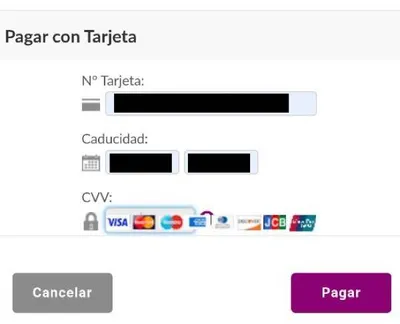
At the scheduled time of 04:20, I arrive in Dijon. I have more than two hours until my train, and nothing to do other than wander around the old town. I’ve never seen even a photograph from Dijon before, only knowing because of the mustard, so I’m delighted to discover that it is a lovely old city. The streets are empty at this time of the morning, except for some scattered drunkards on their way back home.
After wandering through the city for a couple of hours, I arrive back at the train station. I’m surprised to see that there are actually quite a few people catching the first train of the day on a Sunday morning. I try to find any place that would sell me coffee – even a damn machine, but to no avail. Thankfully, the train departs promptly at the scheduled time of 6:43.
I now manage to buy the Renfe tickets for my train from Valencia to Malaga… Success! I try to catch some sleep, but the rising sun isn’t helping, and I manage to get only about 20 minutes before arriving in Lyon at 08:45.
Now my mission is to find breakfast before my 10:10 train. Being in France, I want to get a nice croissant, but most of the bakeries close on Sundays. After a bit of research, I manage to find one open inside the market, and I promptly get a croissant and a pain au chocolat. Oh, they are so good. The French really know what they’re doing.
I now have the best part of an hour to bask a little bit in the sun, and I’m doing just that when at 09:44 I get that text message. And just like that, with that 20-minute delay, all those plans collapse like a house of cards. There’s no chance the train will make up enough time to make my connection in Narbonne.
So… what now? I know there’s no better option than to take that same train to its final destination, Toulouse, and go from there to Andorra, but that means abandoning any hopes of going overnight to Valencia. I go check the departure boards, in the off-chance that I’ve missed any other train that could get me there sooner.
I find Dave looking at the screens, and joining him is also Andrew M., who arrived in Chamonix on the same bus as Alex L. last night, although I didn’t see him get off the bus. We catch up on the developments, and Dave tells me that he, in fact, got the 3:26 bus with Alex, who appears to have decided on the spot to compete in the points (or most countries visited) category rather than for the fastest finish, and has gone East.
Seeing as there are no other options, I get my ticket for the Narbonne to Toulouse leg of the train and wait for the delayed departure. The train ends up leaving over 20 minutes late, and I settle down for another long journey in a table seat. Just my luck.
I’ll go through the five stages of grief during the day, but not necessarily in order. Denial went off quickly in Lyon while I processed the ramifications of the delay. I knew the plan was tight and risky; however, I was mainly concerned about delayed buses. The TGV should have been a reliable part. It was also the first part of the itinerary, which makes the whole thing even worse.
Anyway, it’s time to enter the bargaining stage and see if I can still arrive relatively early in Valencia. As things stand right now, this seemingly inoffensive 20-minute delay is going to make me arrive at the finish line exactly 12 hours later than I originally planned. My itinerary to Valencia looks like this at the moment:
- This train, arriving in Toulouse at approximately 14:35, after accounting for the delay
- The 17:45 bus from Toulouse to Andorra la Vella, arriving at 21:45
- The 22:15 bus from Andorra la Vella to Barcelona, arriving at 01:15
- The first train in the morning to Valencia, departing at 07:15, and arriving at 10:10
After the travel research equivalent of banging my head against a wall for a solid couple of hours, I find nothing. Nothing except one thing, something quite bizarre. I can see that there is a Flixbus service coming from France that stops in Barcelona at 2:15 AM and arrives in Valencia at 6:30 AM. While this isn’t as good as my original plan, it is still much better than arriving after 10 AM. The only problem is that I’m unable to book it. The Flixbus site allows you to buy tickets from any of the stops in France, but not from anywhere in Spain.
As much as I research, and I do research, looking for crazy alternatives from every stop I’ll hit along the way, there isn’t any other alternative. I have a little scare when the train stops in Valence, as I look out of the window and see a Renfe train. For a second, it seems that I might be able to jump off this train and get on my way to Barcelona, but I soon realise that said train is going the opposite way, back to Lyon.
After a gruelling journey where I don’t catch much sleep, we finally arrive in Toulouse. I reunite with Dav and Andrew, and we all head to the bus station to confirm that the 17:45 bus to Andorra exists and is scheduled.
We have three hours to kill in Toulouse, and at least the weather is lovely, so we find a place with outdoor seating to have a nice lunch and drown our sorrows with some French wine. A little less wine than we paid for, by the way, as the waiter acting as self-appointed sommelier insists on trying the bottle as well to double-check if it’s corked or something, only to pour a whole serving and then, not so subtly, bring the glass to one of his mates on another table. Cheeky little bastard. We all desist from arguing because we’re all low on energy and have other things to focus on.
Over lunch, where I try frog legs for the first time in my life (they really do taste just like chicken), we discuss the situation we find ourselves in. I make a pact with them: I reveal the existence of the ‘ghost’ unbookable bus from Barcelona, in exchange, they need to share with me a way to book it if they find one.
What about the people going through Mallorca? Well, I soon realise that I was very wrong in dismissing that route out of hand. They appear to just have left the port of Barcelona, on a ferry on the way to Alcudia, on the north end of the island. We quickly check their options, and the picture doesn’t look good for us. They can cross the island to Palma in the South, clear the checkpoint there, and be on their way to Valencia on an overnight ferry. Unless there are any hiccups, they will arrive in Valencia two hours ahead of us, which doesn’t seem like much, but it really is, as it will allow them to fly past Spain while we are going to be stuck in 2-hour long service gaps along the way.
Our chances of winning are slim. There are only two paths to victory for us: either one of their ferries gets significantly delayed (which is not unreasonable to think), or we manage to find a way to book that bus from Barcelona to Valencia. Those are not very good odds, and I enter the depression stage of my grieving journey.
We arrive early at the bus station –there’s no chance we’ll miss our bus to Andorra. Soon, Ben P., whom I had also met during last year’s race, appears and joins our group. Our transport, a mini-bus (emphasis on mini), arrives promptly, and we depart on time.
After a brief stop at the Toulouse-Blagnac Airport, where I have the chance to spot an Airbus Beluga XL, we’re on our way to Andorra. I try any option I can find to book the ‘ghost’ bus. Every possible reseller. Every bus comparison website. Every Spanish travel agency. Nothing.
I try to call FlixBus Spain, but their customer service only works on weekdays. I try with the main English support line, and after listening for an ungodly amount of time to some horrible holding music, I finally manage to speak with a FlixBus rep. I explain the situation, provide all the details, but the answer that I get is the one I anticipated: computer says no.
I manage to nod off for a while, and when I wake up, the bus is slowly starting to climb the Pyrenees. The views are spectacular. It’s a shame that I’m too rushed and tired to take them in properly.
As the bus enters Andorra La Vella, I’m firmly in the anger stage of the grieving process (I said I wasn’t going through the steps in order), and when the bus arrives, I need to be alone and split off from the group. As I anticipated, the task for the Andorra checkpoint is quite straightforward: we’re supposed to take a photo with a depiction of the Principality’s Coat of Arms. As soon as I step off the bus, I find the first one on its number plate. I’ll collect a few more as I walk through the steep streets of the capital’s old quarter.
Leg 4: Andorra to Valencia
I get back to the bus station at 22:00, where I meet Andrew and Dave again. Soon, we get more bad news.
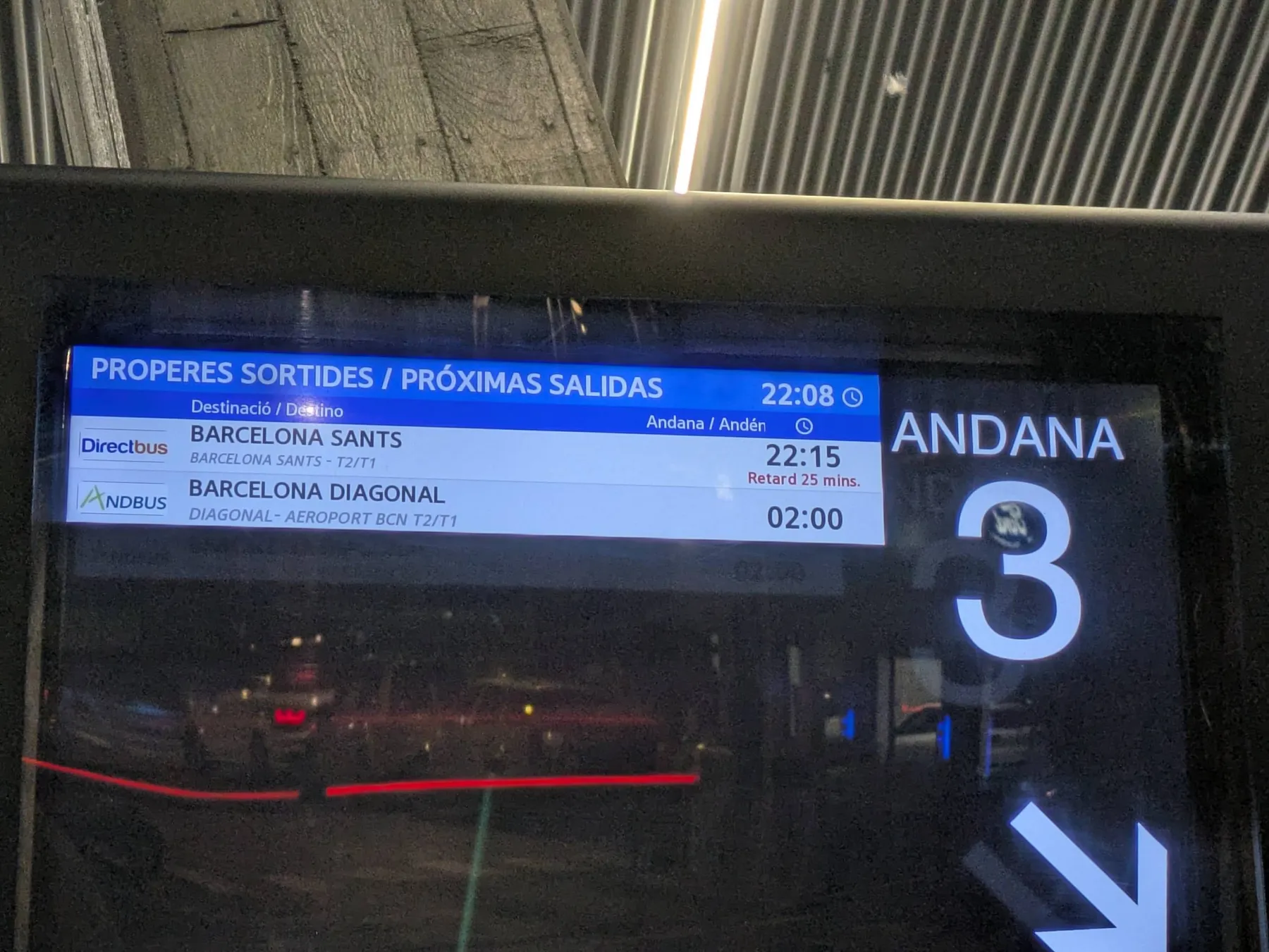
Time passes and there’s no sign of the bus driver. After almost 50 minutes after the scheduled departure, he finally arrives, and we board. I fall asleep almost as soon as the bus starts going, only to be woken up at the border. Two Spanish policemen board to check passports and customs, which takes quite a bit longer than I expected.
The next time I wake up, we’re already in Barcelona. We arrive at Sants Station at 1:53 in the morning. The ‘ghost’ bus is scheduled to arrive between 2:10 and 2:15. In anticipation, I have bought tickets on that bus from Perpignan to Valencia. FlixBus’ policy states that you’re not allowed to board a bus at a stop later than the one you booked, but one has to try.
As the native Spanish speaker in the group, I prepare myself to plead with the driver, perhaps improvising some sob story. I open the FlixBus tracker to see how far away the bus is, and to my delight, it is already quite near us, just five minutes away. Except… wait a second. It’s actually five minutes past us. If I weren’t so tired, I’d have an emotional response to this.
Well, that’s it then. The overnight ferry from Palma has departed on time with our rivals presumably on board. So, unless there are any major surprises, we have lost, still more than 1,400 km away from the finish point.
I leave my travel and sorrow companions at the bizarrely Star-Wars-themed hotel annex to the train station, now needing to sort out my own accommodation for the night. I haven’t booked anything as I still had a little bit of hope.
The first train to Valencia departs at 7:15. I check the prices of nearby hotels and hostels, but they’re through the roof. Unwilling to waste more money (thank good I at least got refundable tickets for the expensive Valencia - Madrid - Málaga leg), I resign myself to mindlessly wandering the streets of the Catalan capital. At least I have a very topical song to keep me company.

I book the train tickets to get to Valencia tomorrow, and then from Valencia to Málaga. While I could also go to Algeciras (the port where the ferry to Tangier departs from) via my hometown of Seville, and still take the same ferry, the connection through Málaga is more reliable, as there are way more buses to Algeciras departing from there.
Time does go slowly, but at some point past 5 AM, I make my way back to the station, which is now open. The layout of Barcelona Sants is a terrible maze, caused by the stupid boarding procedures of Spanish long-distance trains. Unlike in most countries, where you can simply walk into the station and go to your platform, you must arrive with plenty of time, wait for your platform to be announced, pass through airport-style security, and then queue to enter the platform only when directed by the staff.
As a result, the station has been made into a cumbersome labyrinth to separate different areas. There’s also not much seating (why would you need that in a major transport hub anyway?), but I manage to find some and collapse into it. To add insult to injury, the toilets (which of course are not free) do not even open until at least an hour after the station does.
When the time finally comes to board the train, I discover to my horror that I’m seated in the only row of facing seats of the coach. A few moments later, my seat companions arrive, a sales team of three talking shop quite loudly. Not that it matters too much, I am battered, and I fall asleep quite quickly. I sleep for two hours straight. I wake up as the train stops in Castellón, and to my horror, I realise that I have been drooling quite a bit, so much that there’s a visible puddle on my t-shirt. I’ve given those sales reps a good spectacle. Anyway, since there are no more stops until Valencia, I get up and manage to find an empty row of seats where I can stretch my legs. A school trip gets in the way of any further sleep, but it’s still a good trade-off.
The train pulls into Valencia Nord station just a few minutes late, and I set out to clear the checkpoint. Before leaving, I spend a couple of minutes admiring the impressive modernist architecture of the station building. Valencia’s central station, Joaquín Sorolla, is nothing more than a glorified bus shelter, but Nord is a charming building.
It’s a 20-minute walk through the beautiful streets of Valencia’s city centre to the checkpoint spot, La Casa de Los Gatos –a miniature house for stray cats built by the neighbours. I get there by 10:45. The leading pack, who arrived in Valencia without a hiccup, were here only 2 hours before me. However, due to train schedules, while they are well on their way to Madrid (again, a consequence of the Spanish Railway Network’s design, which requires a stop in Madrid to reach pretty much any destination), I still need to wait here for almost two hours.
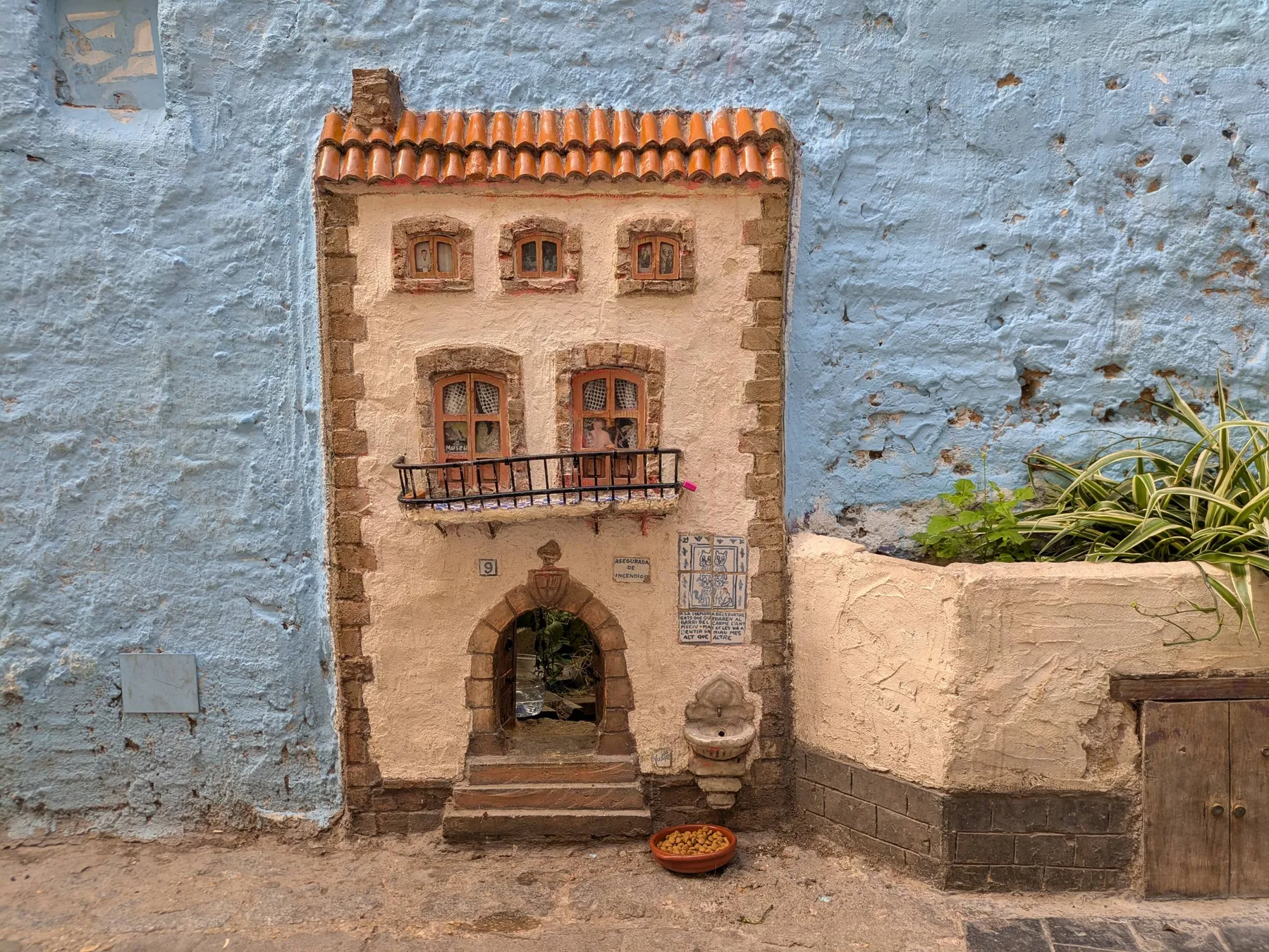
Leg 5: Valencia to Tangiers
I haven’t seen David or Andrew since Barcelona, but I know they can’t be too far away. Anyway, it’s time for me to prepare for the rest of the journey. I make my way to the Valencia Joaquín Sorolla station and set up shop in a nearby café. I order a Coke Zero and bring out my laptop, ready to confirm, once again, that there’s no faster way for me to get onto African soil than the one I’ve already chosen.
It’s a bit frustrating to be frank.If I had arrived in Valencia less than an hour earlier, I could have been on my way to Málaga almost three hours earlier. In the same way,if I could arrive in Málaga just 25 minutes earlier, I could connect to Algeciras immediately and have a slight chance of making it to Marrakesh tonight. And, of course, if my grandma had wheels, she would be a bicycle.
The online timetables weren’t lying to me, and the booking website confirms that, while buses to Algeciras depart throughout the day in 45-odd-minutes intervals, I’ll arrive in Málaga just at the beginning of a two and a half hours gap. Well, that’s not exactly true. There’s a bus to Algeciras at 19:40, but because it makes more stops on the way, it actually arrives 30 minutes later than the 20:00 service. At least I realized that when booking the tickets.
I book the first available ferry, the 23:59 to Tangier Med from Algeciras. This is another consequence of the delay: I won’t make it to the Southern tip of Spain in time to catch one of the daytime ferries from Tarifa, which are far superior as they leave you in the port of Tangier Proper. The port of Tangier Med is located 50 km away from the city, and the only public transport option between the two is to use a scammy taxi.
I will get to Morocco just past midnight (Morocco is on the same timezone as the UK, so you gain one hour coming from Spain), well past any hopes of catching the last southbound train. That’s the big reason why I have tried relentlessly to find a faster way to Tangier: if I had been able to get there before 23:00, I would have had a chance to catch the 23:45 sleeper train to Marrakesh, which according to my calculations is the one that the leading pack are going to take, as they will arrive in Tangier around 21:00. My original plans, had they not been completely derailed, would have put me on the last high-speed connection via Casablanca, departing from Tangier at 19:00.
Given that I’m certain I’ll have to wait for the first train tomorrow, which departs at 6:00, and I’m unwilling to spend another night wandering around the city, I also book a hotel. I find a reasonably priced room at the Ibis next to the train station. I look forward to catching some proper sleep, but, even more importantly, having a shower.
I finally make my way to the station. Now all the plans are set, and there is no way I’ll have to change them, except in the event of a catastrophic, hours-long delay. I only have to go through the motions and make it to Tangier to fight for the 7th spot, as I think there are six competitors in the leading pack. In my group, I count five other racers, besides myself: Dave, Andrew, Ben, and a team of two I met this morning in Barcelona. I’ll still need to prepare for a sprint finish if I want to make it into the top 10.
I board the train and have an enjoyable and uneventful ride to Madrid. Once I get there, though, I’m going to have to rush: I arrive at Chamartín, Madrid’s northern terminus, but the trains to Málaga depart from Atocha, in the southern end of the capital. I have 40 minutes to get there, which sounds like a lot, but is actually a bit tight considering that you have to account for the stupid security and boarding procedures of Spanish intercity trains, and that Atocha is a terribly laid out station, spread out in a long rectangular shape, so getting from one end to the other can take some time. Fortunately, a high-frequency commuter train service between the two should make the transfer relatively easy.
I arrive at Chamartín on time, and getting out of the high-speed train and changing to the commuter service to Atocha is a terrible experience. I have only been here once before, 10 years ago, and I had forgotten how much this station sucks. There is only one way to get out for all platforms, through a narrow underpass that is completely crowded. Since the commuter line platforms at Atocha are located behind turnstiles, I have to exit and re-enter the station. Fortunately, I can at least use contactless payment for the ticket.
There are only about six ticket gates to exit at Chamartin, and only one of them is open for passengers coming from long-distance service who obviously don’t have a ticket for Madrid’s commuter trains. It’s utterly chaotic. I manage to push my way out and back in again. I manage to find the platform for the next train to Atocha, departing in two minutes, from the only departures board there, which is an old, fading TV placed in the middle of the underpass. Thankfully, I manage to run and get on the train just in time.
The train is full of people, but I manage to find some standing room in one of the last carriages. While I’m holding the handrail, I suddenly realise, to my complete shame, that I stink. It’s an unsurprising development, considering that it’s a Monday afternoon and the last shower I took was on Saturday morning. Anyway, there’s nothing I can do right now apart from trying to keep my arms closed together.
By the time I arrive in Atocha, the train is completely packed. I overtake as many people as possible on the way out, as I have to run the whole length of the station until I make it to the departures area for my connection to Malaga. Fortunately, there’s no queue at security.
After, again, having to queue for boarding, I sit down and prepare to be taken South, but first I make a visit to the train toilet to freshen up a bit, change t-shirts, and put on a copious amount of deodorant. That makes a difference, and as soon as the train leaves Madrid, I nod off.
I sleep for a good hour and a half. Soon enough, I arrive in Malaga at 17:45. After going to the bus station and confirming that there really are no other buses to Algeciras that I can catch before 20:00, I have two hours to kill here. It’s actually quite hot, so I head to the shady streets of the city centre, making a stop first to grab a bocadillo de jamón.
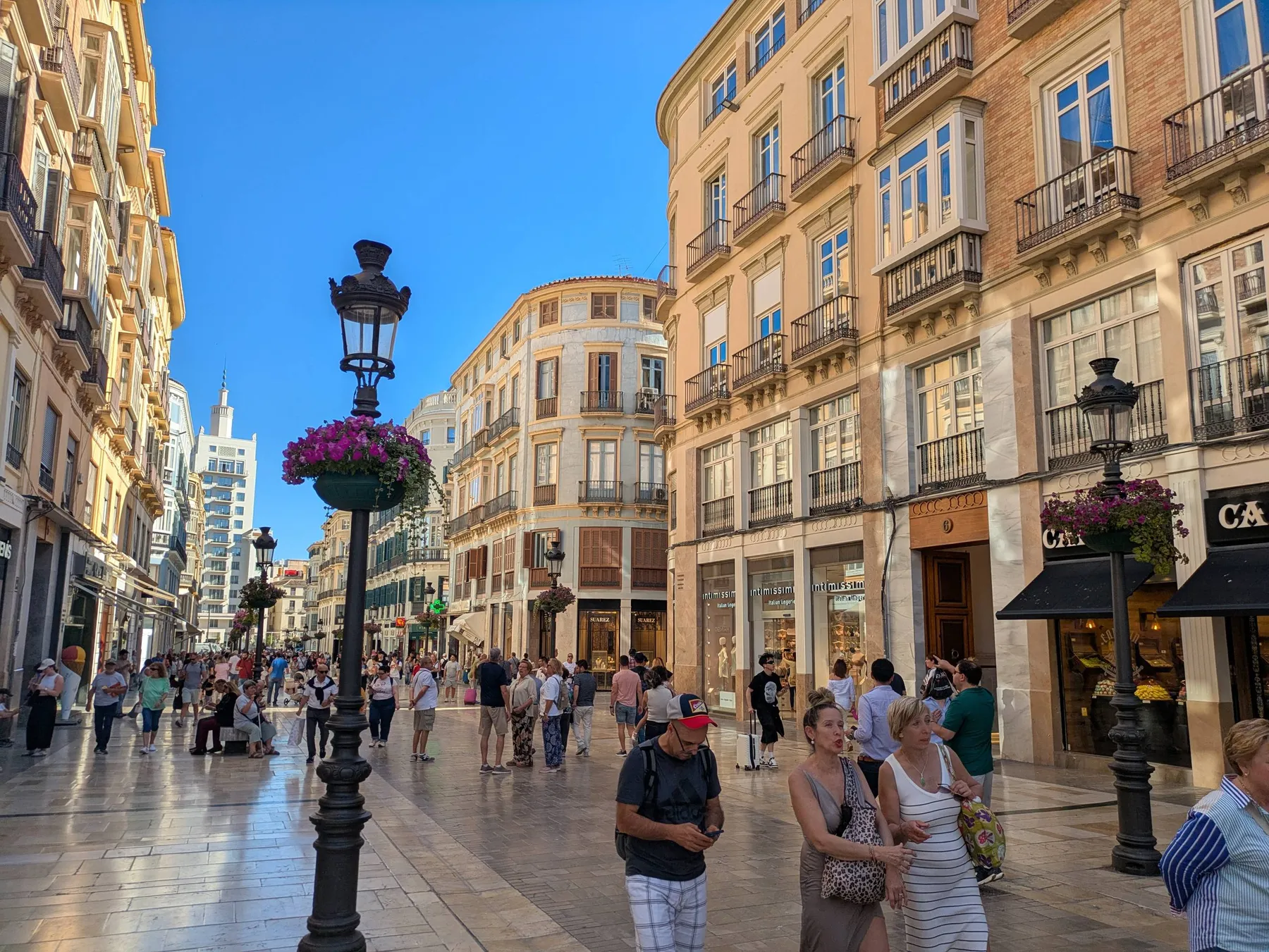
In other circumstances, having some time to kill in Málaga would have been lovely, but I just want to get to Africa. Finally, it’s time to board my last bus in Europe, which promptly departs at the scheduled time of 20:00. After a pleasant ride with sunset views over the Strait of Gibraltar, I arrive in Algeciras exactly at 22:00.
I make my way to the port immediately. Before heading to the departures area, it crosses my mind that I might as well check the departure board in the ticket office. Not surprisingly, I see that the 21:00 ferry is delayed and hasn’t departed yet. With nothing to lose, I ask the clerk if I can change my ticket to board that one. He pulls out a walkie-talkie and asks his colleague on departures if the boarding is closed yet. To my delight, I’m just on time, and the clerk agrees to exchange the ticket on the condition that I run to the ship, as they’ll close the boarding after me. I almost can’t believe it, my first real stroke of luck in the race! It won’t be enough to get me to Tangier in time for the overnight train to Marrakesh, but at least I’ll be able to stay in my hotel room for a couple more hours.
They weren’t lying, and I see how they close the boarding gate behind me, before directing me and a couple of other passengers who were waiting there to go to the ship. It seems that there’s someone else they need to get there, but whoever they are, they are using the toilet at that moment. Not thinking too much of that, I make my way to the ship. As I’m about to board, I look back to see Andrew walking a couple of metres behind me.
After exchanging greetings and catching up, we join the queue for passport control, which, on these ferries, is done aboard the ship, so you can get out when you arrive. I haven’t thought about it, but, weirdly, I haven’t seen Andrew, Dave or Ben since the morning. The other team of two actually came on the bus to Algeciras with me, but they probably haven’t realised that it was possible to get on this earlier ferry. Of course, as long as they cross the Strait of Gibraltar tonight, it won’t matter too much.
While we were boarding the ferry, James, the Race Director, had sent an update: the tracking wasn’t updating properly for the leading pack while in Morocco, but they were on their way to Marrakesh and expected to get there around 02:00. I speak with Andrew about that. We’re both a bit puzzled: that time doesn’t seem to make any sense. The overnight train they could take doesn’t arrive until 09:14. The earlier train connection departed at 19:00. For a moment, we consider the possibility of them taking a long-distance Grand-Taxi (which are permitted in the race rules) to get to Marrakesh. We contemplate sinking a good chunk of money into turning the final stretch of the race into a taxi chase like some sort of action B film.
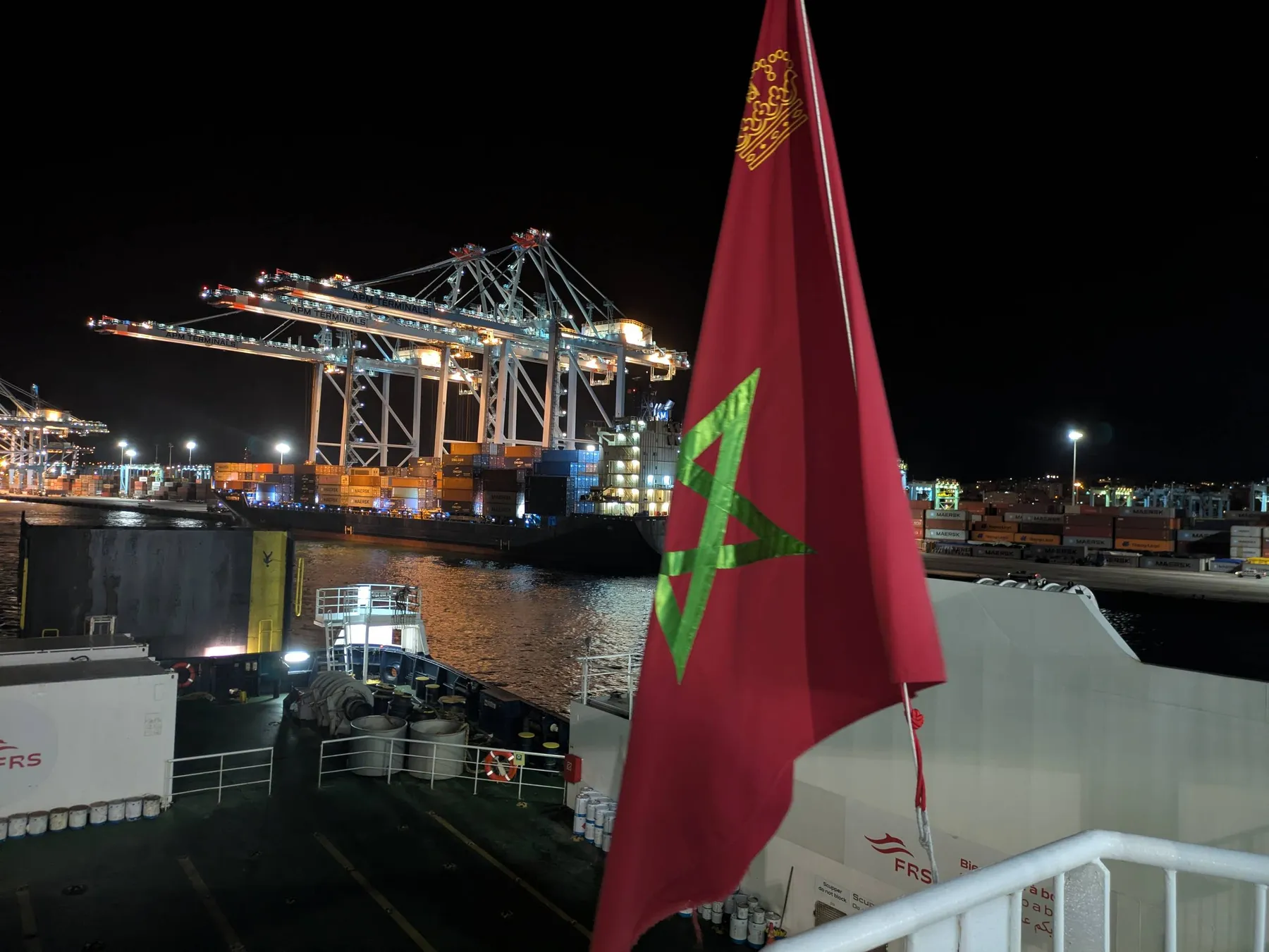
The ferry still takes a while to depart, not moving until almost 23:00. After spending a while looking at departures and timetables, I realise what they’re doing: they’re catching one of the latest high-speed trains to Casablanca at 21:00 or 22:00, arriving at around eleven or midnight. While there are no trains to Marrakesh at that time, there are buses well into the early morning. I think the 2:00 estimate is a bit tight, but in any case, they’ll arrive there hours before I can even leave Tangier. It’s time to finally forget about the frontrunners and focus on being the first of my pack.
Soon enough, the coast of Africa appears in front of us, and we get ready to disembark, descending into the truck-filled car garage. The gargantuan gates of the ship open, while an alarm blares, making the loudest sound I’ve heard in my entire life. A bus is there waiting to take us to the terminal.
Once there, Andrew tries to find a working ATM to take some cash to pay for the taxi to Tangier proper, but he has no luck with any of the available machines. Fortunately, I’ve been farsighted enough to have exchanged some cash in advance, so I can cover for him.
With anyone else having their own transportation, we’re the only ones venturing out by foot outside the passenger terminal, and into the middle of nowhere in northern Morocco. We find the taxi rank, and when the driver quotes us the price, 40 euros, we have to take it, as we don’t have much leverage: our only other option is to wait here six hours until the first bus into town.
I try to explain our destination to the taxi driver, who can’t grasp why on Earth we don’t want to be let off at a hotel like any normal tourist. The race rules, however, only allow us to take grand taxis from a designated stop to a designated stop. Fortunately, the grand taxi stop in the city centre is very close to the checkpoint. After showing the driver the exact spot on the map, and insisting that we want to get there, we set off af 00:30.
The ride into Tangier is pretty uneventful, although it is quite a contrast to see how much life cities in Morocco have into the wee hours of the morning, compared to the Alpine towns I was just a couple of nights ago. We drive into Tangier, passing by the train station, but after a while, Andrew starts getting a bit suspicious and asks me if we’re on the right track. I look at Google Maps and discover that we’re getting away from Tangier. I ask the driver, and he says that this is the way to the grand taxi stop. I have to trust him, as perhaps he’s going around the centre through main roads instead of crossing it. However, after a while, it becomes apparent that we’re going out of the city, and I become a bit uneasy. I ask the driver again, who reassures me that we’re going to the grand taxi stop.
I ask if we’re going to the grand taxi stop near Cinéma Rif (which is actually one of the two possible checkpoints). The driver seems confused, asking if we want to go to the grand taxi stop or to Cinéma Rif. I understand what’s happened: even though I showed the location on the map clearly and explained where we wanted to be taken, he skipped all of that and only understood that we wanted to be taken to the city’s grand taxi stop. While it’s true that there’s a small one near Cinéma Rif, the main one, which is the one actually used to fleet long-distance shared taxis, is on the outskirts of the city. Once we clear the misunderstanding, the driver reroutes us to our intended destination.
At 01:32, we finally take the required selfie in front of Cinéma Rif. We’re set for Marrakesh.
Leg 6: Tangiers to Marrakesh
We take a petit taxi to the hotel, and I’m pleasantly surprised when I’m told that the taxi uses a meter. It’s the first time that has happened to me in Morocco. We arrive just past 02:00, and the first thing I do is have a badly needed shower. I also decide to throw away the nasty socks I have been wearing for the past three days, after having to peel them off my feet.
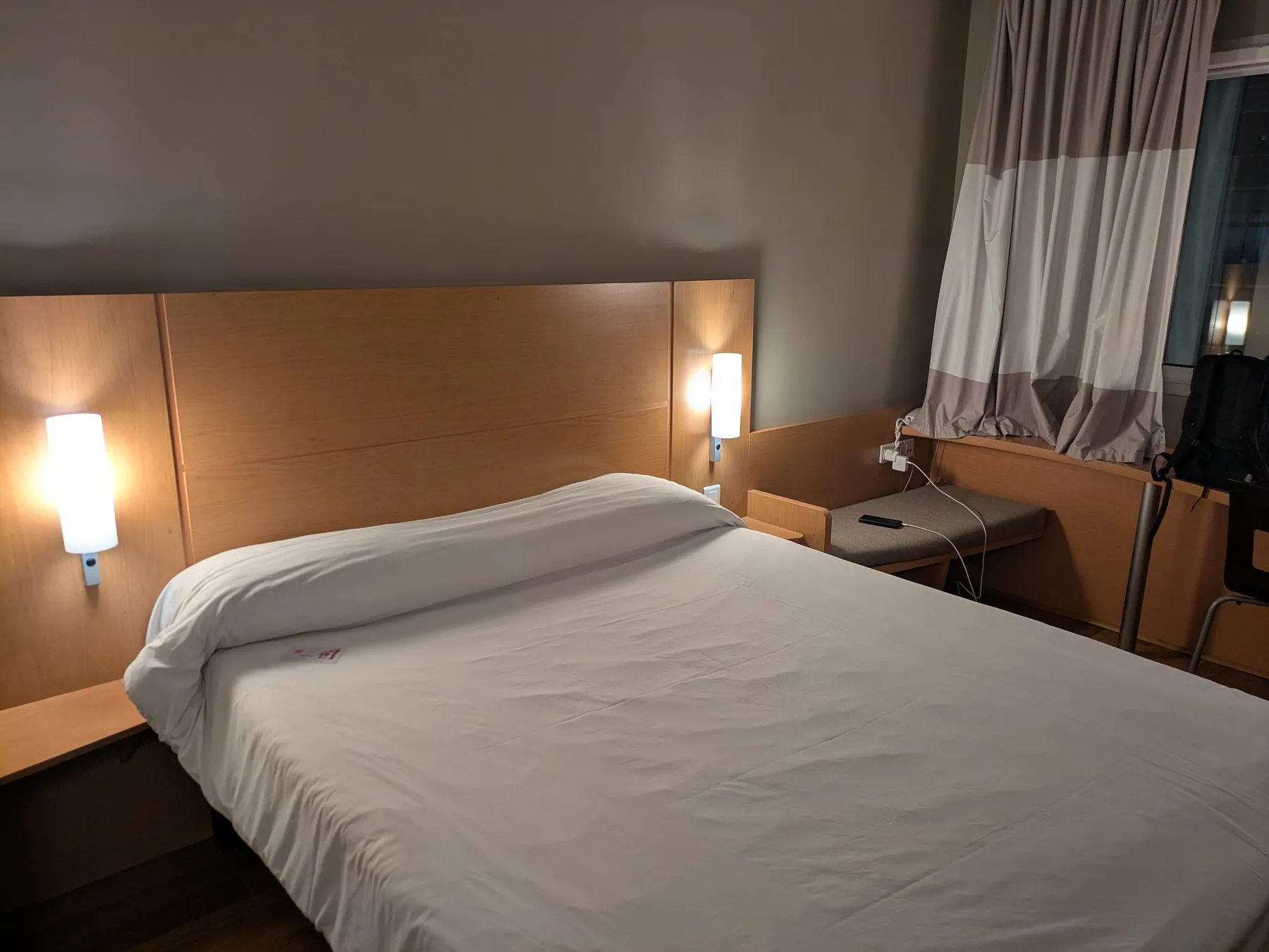
I wake up at 5:00, ready to tackle the last stretch of the race. While I was sleeping, the leading pack arrived in Marrakesh. I check the WhatsApp group for updates, and I learn that Sam S. has won the race! I’m really happy for her. I guess she had the last laugh after I left her behind in Paris.
After another shower, I make my way to the train station, where I encounter Dave and Ben. We greet each other and catch up over a much-needed coffee before Andrew joins in as well. We make our way to the train, and I’m pretty excited, as we’re taking the only high-speed railway in the African continent, the Al-Boraq.
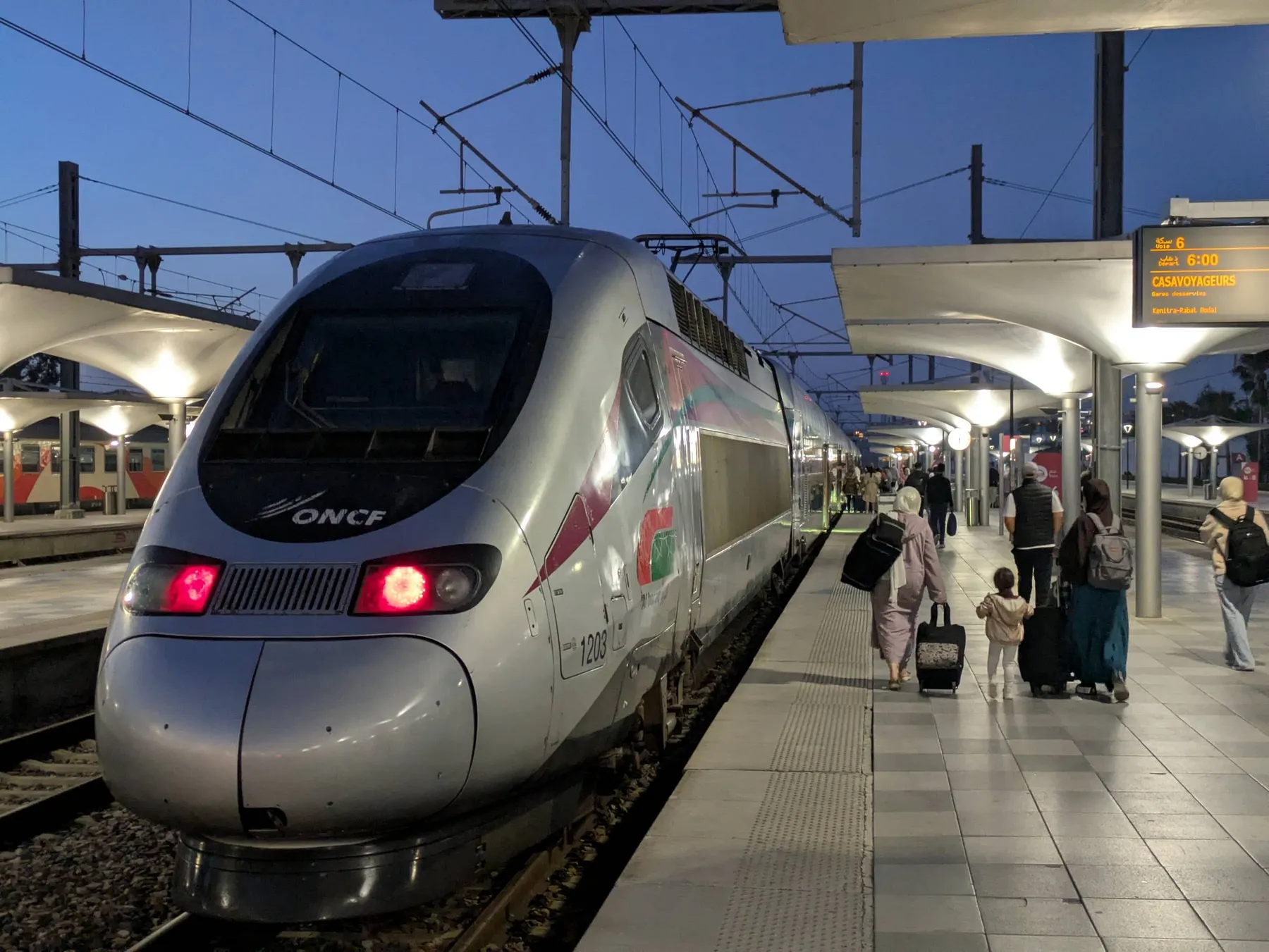
The train departs promptly at 6:00, and I manage to nod off for almost the whole two hours it takes us to get to Casablanca. Once there, it’s a 35-minute transfer to an old-school Moroccan train (the kind where you can see the ground through the hole at the bottom of the toilet). Andre, Ben, Dave, and I are seated close to each other in the same First Class carriage.
The ride is two hours and forty minutes long. During that time, you really get a feel of the arid landscape that comprises the Moroccan countryside. As the journey progresses, the tension starts to be more palpable, as we’re all still competing to get the highest possible spot, which we think is the 7th place –we’ll realise later that actually there was another racer in the leading pack, so it was actually the 8th place we were fighting for.
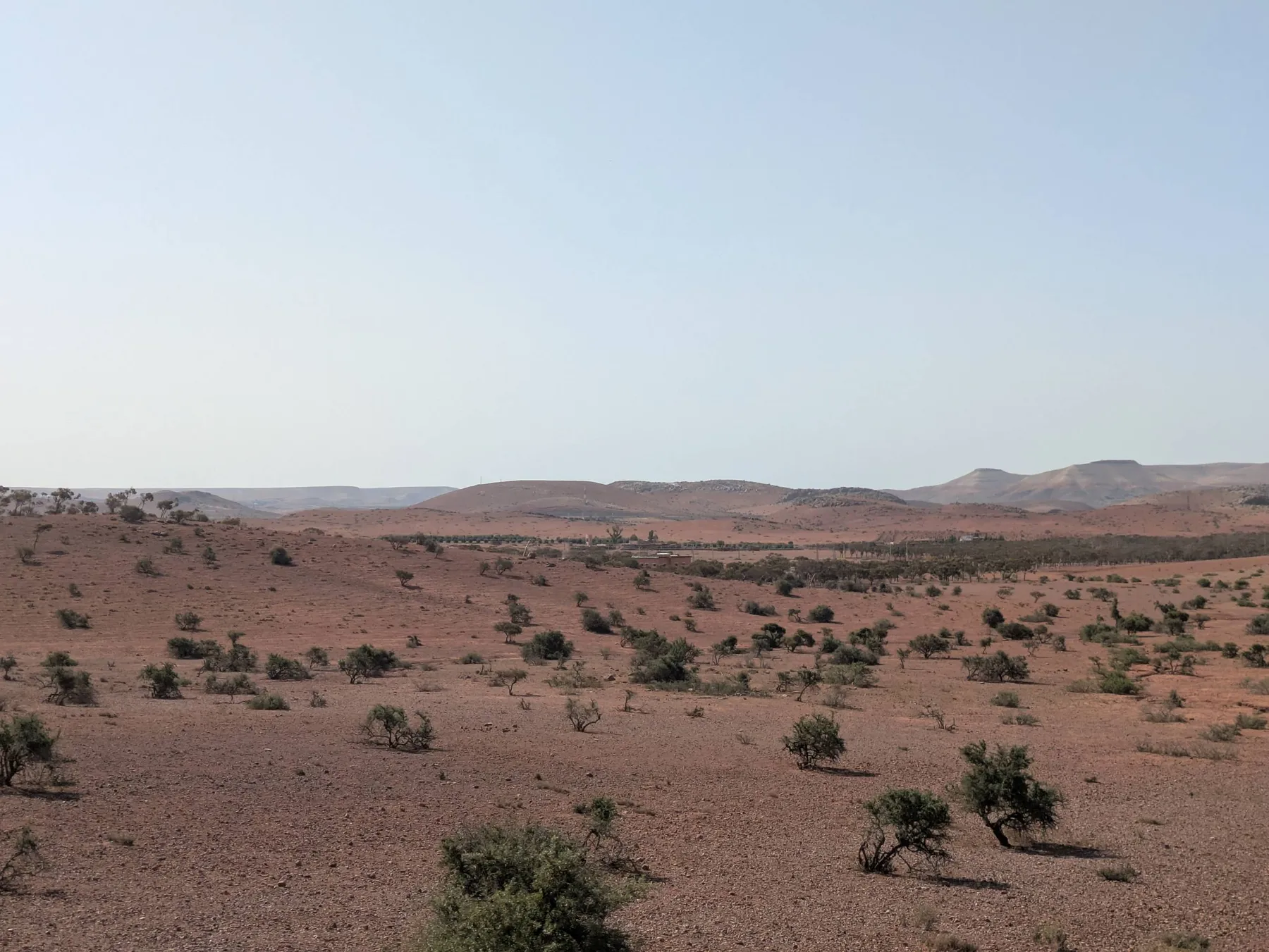
I pull a move as the train departs the last station before Marrakesh, and I move myself to the first seat of the carriage, so I’ll be able to leave the train first. With still more than half an hour left till Marrakesh, Dave raises the stakes and goes to stand up directly behind the door. We laugh as game recognises game.
Once the train starts pulling into the Marrakesh terminus at 11:11, a family that was also standing behind the door opens it with the train still in motion. Dave was unlucky, as it’s the right-hand side door that opens instead of his. It was a 50-50 shot. As we get off the train, I start sprinting like a madman and overtake Dave and every other passenger. I make my way out of the station and am lucky enough to catch a taxi that is stopped at a red light just there. We’re already leaving when I see Dave scrambling to find another cab.
Before we hit the finish line, we need to clear the last checkpoint: the famous Chez Lamine Hadj Mustapha restaurant, on the northern side of Jemaa el-Fnaa, the main square of the city. I have directed the driver to head to the Koutubia, the eight-hundred-year-old Friday mosque of Marrakesh, which is just across the road from the square.
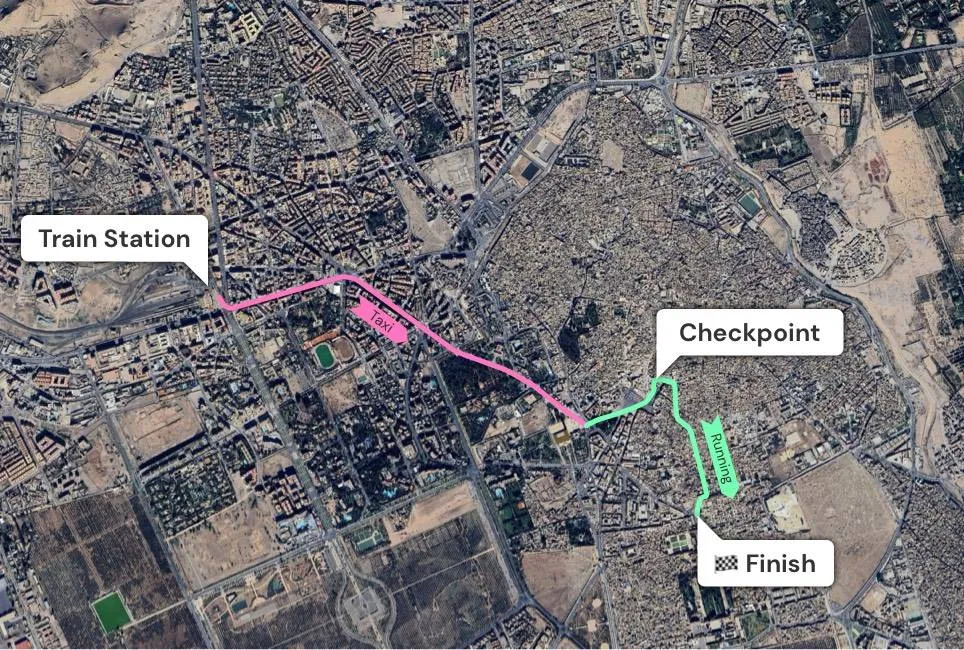
As soon as the taxi stops at a red light next to the mosque, I give the driver a few dirham notes, and, without waiting for the change (to my surprise, this taxi also used a meter), I leave and start running to cross the street. By 11:23, I’m taking a selfie at the checkpoint, before heading South through the narrow streets of the Medina in search of the finish line, now just 1 kilometre ahead of me. I try to run as much as possible, but I’m constantly blocked by locals, tourists, and motorbikes.
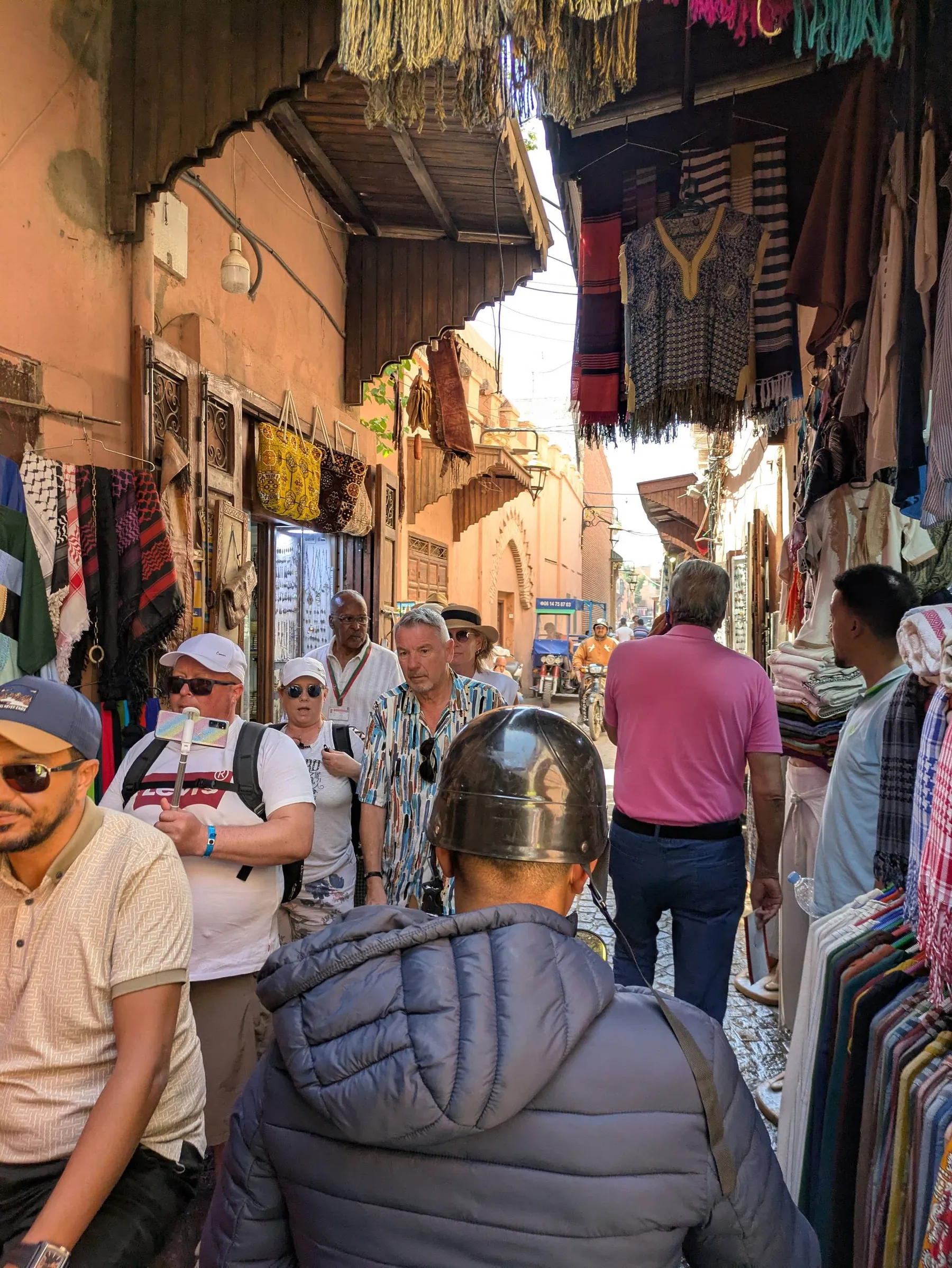
I finally arrive at the finish line at 11:32, where I’m greeted by the race team and a few members of the leading pack, including Sam. I congratulate her on her victory, and get some water. Dave, Andrew, and Ben arrive ten minutes after me –I’ve managed to run faster than I thought possible through all the chaos of Marrakesh. We part ways after catching up over mint tea and a hearty tajine for lunch, and that’s when I finally switch off race mode: now it’s time to relax in this beautiful country for the rest of the week.
Epilogue: A Surprise to Be Sure, but a Welcome One
The next day, as I was having lunch, I got an unexpected text: 3 of the competitors in the leading pack had been disqualified for failing to properly complete a checkpoint. That bumped me from 8th to 5th place! Not the way I’d had preferred to advance in the standings, but hey, I’ll take it. A little bit later, I discover that the disqualified team is actually the one that ‘joked’ about giving me bad directions in Paris.
Well, as the song goes, karma is a relaxing thought.

